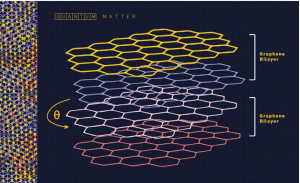NIST Finds a Quantum Ruler to Explore Exotic Matter
Graphene has remarkable properties, especially when you stack up multiple sheets. Should those sheets be twisted at specific angles relative to each other, they exhibit a plethora of exotic identities. These materials, known as moiré quantum matter, can suddenly generate their own magnetic fields, become superconductors with zero electrical resistance, or turn into perfect insulators.
Joseph Stroscio and his team at the National Institute of Standards and Technology (NIST), and an international team of collaborators, developed a quantum ruler to measure and explore the properties of these twisted materials. The hope is that the work may result in a new, miniaturized standard for electrical resistance that could calibrate electronic devices directly on the factory floor. The work was published in the journal Science.
Fereshte Ghahari, from George Mason University, took two layers of graphene approximately 20 micrometers across and created a moiré quantum matter device. NIST researchers then chilled this twisted material device to one-hundredth of a degree above absolute zero, reducing random motions of atoms and electrons and increasing the ability for electrons to interact. At ultralow temperatures, they examined how the energy levels of electrons in the layers of graphene changed when they varied an external magnetic field. Measuring and manipulating energy levels is critical for designing and manufacturing semiconductor devices.
They used a versatile scanning tunneling microscope that Stroscio designed and built at NIST to measure energy levels. When the researchers applied a voltage to the graphene bilayers in the magnetic field, a tiny current from the electrons that “tunneled” out from the material to the microscope probe tip was recorded.
When the NIST researchers varied the magnetic field applied to the moiré graphene bilayers, they found evidence of a new quantum ruler at play. The area enclosed by the circular orbit of electrons multiplied by the applied magnetic field no longer equaled a fixed value but had shifted by an amount dependent on the magnetization of the bilayers. The findings may shed new light on how electrons confined to twisted graphene sheets give rise to new magnetic properties.
In moiré quantum materials, electrons have a range of possible energies determined by the electric field of the materials. The electrons are concentrated in the lower energy states, or valleys. Large spacing between the valleys in the bilayers, bigger than the atomic spacing in any single layer of graphene or multiple layers that aren’t twisted, accounts for some of the unusual magnetic properties.
Because the properties of moiré quantum matter can be chosen by selecting a specific twist angle and number of atomically thin layers, the new measurements promise to provide a deeper understanding of how scientists can tailor and optimize the magnetic and electronic properties of quantum materials for a host of applications in microelectronics and related fields. For instance, ultrathin superconductors are already known to be exquisitely sensitive detectors of single photons, and quantum moiré superconductors rank among the very thinnest.
If researchers could manipulate quantum moiré matter so that it has a net magnetization even in the absence of an external applied magnetic field, Stroscio said, then it could potentially be used to create a new portable version of the most precise standard for resistance, known as the anomalous quantum Hall resistance standard. Calibrations of electronic devices could be performed at the manufacturing site, potentially saving millions of dollars.


